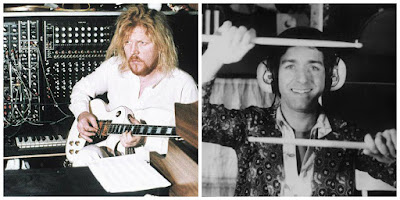1. The Cinematic Orchestra - Ma Fleur
2. Holger Czukay - Movies
3. Klaus Schulze - Picture Music
4. Tangerine Dream - Encore
5. Can - Ege Bamyasi
6. Can - Sacrilege
Well with a pseudonym like Eddy Bamyasi it was inevitable there would be a "Krautrock" entry sooner or later in the blog. The term "Krautrock" in music seems to have been generally accepted without too many negative connotations. Perhaps that is because the purveyors are almost exclusively held in high esteem and are frequently name-checked as hugely influential by more modern artists. Krautrock doesn't literally mean all German rock - it refers to a particular genre arising in the early 70s through bands such as Can, Neu!, Faust, Kraftwerk, Amon Duul, and Tangerine Dream, characterised (very generally speaking) by experimental electronics, and repetitive heavy beats termed motorik.
Here we have three albums shared between Can and Tangerine Dream plus solo efforts from Holger Czukay (of Can) and Klaus Schulze (of Tangerine Dream).
Breaking News! Sadly I have just heard, literally mid post, that Can's drummer Jaki Liebezeit died this week (the music selection being entirely coincidental but subsequently appropriate and poignant). I was surprised to learn he was 78, and was due to play a concert at the Barbican, London, this spring with fellow Can member keyboardist Irmin Schmidt.
Can was one of those bands that blew my mind when I first heard them. I had not heard anything like them before and a huge characteristic of their sound was Jaki's drumming. From that moment on he became, and remained, my favourite drummer.
 |
| Jaki Liebezeit behind his minimal kit and singer Damo Suzuki |
Ege Bamyasi is probably the best starting point for any new Can fans. Released in 1972 with its Andy Warhol inspired soup can cover it is the middle one of the celebrated "Damo" trilogy, offering more focused grooves than both the preceding avant garde epic Tago Mago, and the following more space-prog-rocky Future Days. Can covered a wide range of genres in their music over their core career (essentially 1969 - 1979) including heavy rock, funk, jazz, and electronic, and even classical avant garde and minimalism (founding members Czukay and Schmidt studied under Stockhausen). Well known for their extended jams and improvisations Ege Bamyasi efficiently covers most components of the Can sound across seven tracks of power and beauty, all underpinned by Jaki's metronomic drumming high in the mix as beautifully demonstrated here in Vitamin C.
As well as Jaki's drumming the bone crushing rhythms were augmented by the thump of Holger Czukay's deep bass. Czukay liked to experiment in the studio with other instruments and unusual sampling, and his full ambitions were realised on a number of experimental solo albums - some with collaborators including David Sylvian and Jah Wobble. Movies must be one of the earliest pop/rock albums (1980) to draw extensively upon samples. In particular Czukay would record voices he picked up on short wave radio. The album has two short poppy tunes and two extended experimental compositions. All four tracks have enough ideas for a whole musical career! There certainly wasn't anything else that sounded like this album when I first heard it, and I don't think there is even today. If you would like to delve into the bizarre mind of Holger Czukay start with the Persian Love tidbit and then progress to the soundbite rich Hollywood Symphony.
The Can Sacrilege album was aptly named as it is a double CD of remixes (by Brian Eno, System 7, Sonic Youth, and The Orb amongst others) of revered Can classics. But I don't think purists should be too precious. It's actually very good and the tracks are different enough to be interesting but at the same time retain a lot of what Can was all about. Befitting of the release date of 1997 (and the Can blueprint itself) most tracks are of the drum and bass persuasion giving off a massive sound!
Tangerine Dream, and former member Klaus Schulze, specialise in what I call pulse music. The tracks are all instrumental (I believe Tan Dream only released one album Cyclone with vocals which was panned by the fans, but I actually think is one of their best) and usually lengthy (these two albums for instance each have single LP side length tracks of around 20 minutes each). Unlike electronic contemporaries Kraftwerk the beat is usually provided by pulsing gated synths rather than drum machines.
There is no death, there is just a change of our cosmic address.
Edgar Froese
I guess with the emergence of popular music in the 1960s there will now continuously be artists reaching their 60s and 70s and becoming nearer to a change of cosmic address. While researching this piece I learnt that TD's founder Edgar Froese had passed away in 2015. With each passing a chance to see an iconic artist or band live for the first time passes too - a realisation that has resolved me to buy a ticket to see Damo Suzuki coming to Brighton this Spring. Damo is usually backed by a band of local (relatively unrehearsed I assume) musicians at each gig - an intriguing concept not entirely alien to the former Can front man. One can hope his random sonic journeys will lead to the resurrection of some familiar riffs in his sets.
 |
| German "Krautrock" pioneers Edgar Froese 1944-2015 and Jaki Liebezeit 1938-2017 |
To learn more about some key Krautrock artists have a look at this article http://observer.com/2015/07/8-krautrock-artists-you-need-to-hear-right-now/


0 comments:
Post a Comment